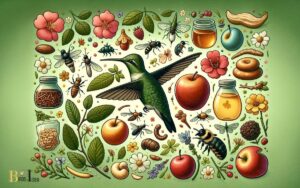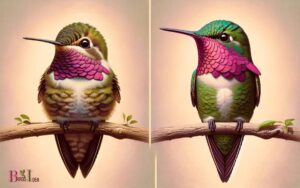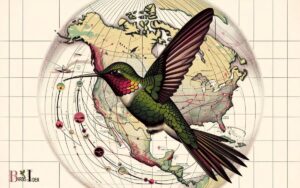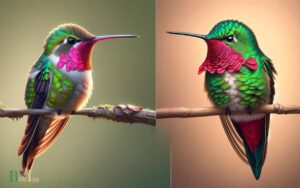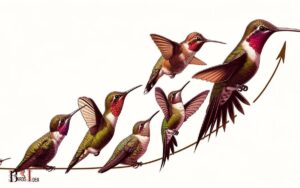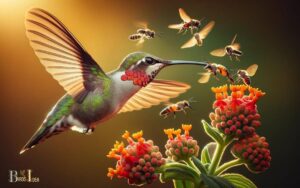What Does Anna’s Hummingbird Eat? Feeds On Nectar!
Anna’s Hummingbird primarily feeds on nectar from flowers, utilizing its long, extendable tongue to reach deep into blossoms.
They also consume small insects and spiders, which provide essential protein. Additionally, these birds may visit artificial feeders stocked with sugar-water solutions, mimicking natural nectar.
The diet of Anna’s Hummingbird is mainly composed of two components:
An example of an Anna’s Hummingbird’s feeding behavior would be quickly darting from flower to flower, hovering momentarily to extract the nectar, and occasionally snatching a tiny insect out of the air or from a leaf.
With their iridescent feathers and acrobatic flying skills, Anna’s Hummingbirds not only captivate onlookers but also play a vital role in pollination as they feed on various flowers.
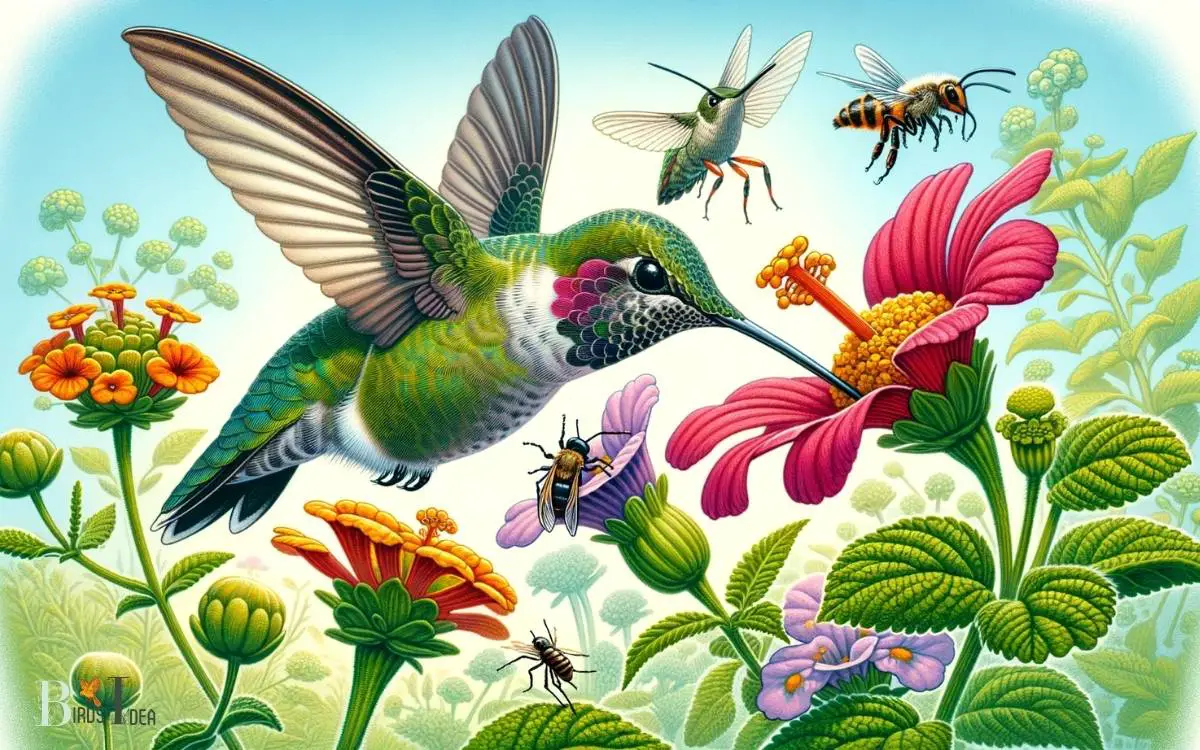
Key Takeaway
Nectar – Their Primary Food Source
Feeding primarily on nectar, Anna’s hummingbirds play a vital role in pollination. Their long, specialized beaks and tongues allow them to reach deep into flowers to access nectar, making them important pollinators for various plant species.
The high energy demands of their rapid metabolism require them to consume their own body weight in nectar each day.
In addition to nectar, Anna’s hummingbirds also consume small insects and spiders, which provide essential proteins and fats.
They are known to feed on a wide variety of flowering plants, showing a preference for tubular or trumpet-shaped blossoms that contain high volumes of nectar.
By understanding the specific dietary habits of Anna’s hummingbirds, we can appreciate their ecological significance in maintaining the delicate balance of various ecosystems.
Insects – A Vital Protein Source
Anna’s Hummingbirds rely on insects as a vital protein source, essential for their high-energy lifestyle.
Insects provide crucial nutrients that support the hummingbird’s rapid metabolism and the demanding energy requirements for their hovering flight.
The high-protein insect diet is a key factor in the hummingbird’s ability to sustain their incredible aerial agility and endurance.
High Protein Insect Diet
In the diet of the Anna’s hummingbird, insects serve as a vital source of high-quality protein. These tiny birds have a high metabolic rate and need a constant source of energy, making insects an essential component of their diet.
Insects provide the necessary amino acids required for muscle development, feather maintenance, and overall growth.
The Anna’s hummingbird primarily feeds on small insects such as fruit flies, gnats, and small spiders, which are rich in protein.
This high-protein insect diet is crucial for the hummingbird’s survival and overall health, enabling them to meet their energetic demands and sustain their active lifestyle.
The protein obtained from insects also supports the bird’s reproductive success and molting processes.
This protein-rich diet ensures that the Anna’s hummingbird remains agile and capable of sustained flight, a crucial aspect of their daily activities.
Energy for Flight
The high-quality protein derived from insects serves as a vital source of energy for the remarkable aerial abilities of the Anna’s hummingbird.
Insects, being a primary dietary component of the Anna’s hummingbird, provide the necessary fuel for the bird’s sustained hovering and rapid flight.
The energy required for the hummingbird’s wing beats, which can exceed fifty times per second during courtship displays, is predominantly obtained from the metabolism of proteins found in insects.
These insects are rich in essential amino acids, such as methionine and lysine, which are crucial for muscle function and energy production during flight.
In essence, the consumption of insects by Anna’s hummingbirds plays a critical role in supporting their extraordinary aerial maneuvers and high-energy activities, ensuring their survival and successful reproduction.
Spiders – An Essential Dietary Component
Spiders are an essential dietary component for Anna’s hummingbirds. These tiny arthropods provide crucial nutrients that support the hummingbird’s high metabolic rate and energy-demanding lifestyle.
Here’s why spiders are a vital part of an Anna’s hummingbird’s diet:
- Protein-rich diet: Spiders are an excellent source of high-quality protein, crucial for muscle development, repair, and overall growth in hummingbirds.
- Essential nutrients: Spiders contain essential nutrients such as vitamins, minerals, and fatty acids that are beneficial for the hummingbird’s health and well-being.
- Feeding behavior: Anna’s hummingbirds are adept at catching spiders using their long, specialized beaks and agile flight maneuvers, showcasing their adeptness in obtaining this essential dietary component.
Tree Sap – An Occasional Nutrient Boost
Tree sap serves as an occasional nutrient boost for Anna’s hummingbirds, supplementing their diet with additional carbohydrates and trace minerals.
While these tiny birds primarily feed on flower nectar and insects, they are known to occasionally visit sap wells drilled by sapsuckers or sap-producing insects.
The sap provides a quick source of energy in the form of sugars and essential trace minerals such as calcium and potassium.
Below is a table showing the approximate nutrient composition of tree sap, which highlights its potential benefits as a supplement to the hummingbird’s diet.
| Nutrient | Amount per 100g |
|---|---|
| Carbohydrates | 85g |
| Calcium | 24mg |
| Potassium | 256mg |
| Sodium | 13mg |
| Iron | 0.1mg |
Pollen – A Lesser-Known Dietary Element
Pollen is a lesser-known but important dietary element for Anna’s Hummingbirds. It serves as a significant food source for these small birds, providing essential nutrients and energy.
Understanding the role of pollen in their diet sheds light on the diverse and specialized feeding behaviors of Anna’s Hummingbirds.
Pollen as Food Source
A significant component of the Anna’s Hummingbird diet includes the consumption of pollen, which serves as a lesser-known but essential dietary element.
- Nutritional Value: Pollen is rich in protein, amino acids, vitamins, and minerals, providing the hummingbird with essential nutrients for its energy requirements and overall health.
- Feeding Behavior: Anna’s Hummingbirds obtain pollen by visiting flowers and using their specialized beaks and tongues to extract it from the stamen. This behavior not only serves as a food source but also contributes to the pollination of plants, making them important pollinators.
- Supplement to Nectar: While nectar is the primary source of energy for hummingbirds, pollen complements their diet by offering additional nutrients, making it a crucial part of their overall nutritional intake.
Importance of Pollen
An essential dietary element for Anna’s Hummingbirds, pollen frequently serves as a rich source of protein, amino acids, vitamins, and minerals, contributing significantly to their energy requirements and overall health.
Pollen is a crucial component of their diet, providing essential nutrients that support their metabolism and immune function.
The diverse range of nutrients found in pollen aids in maintaining the hummingbird’s overall well-being.
Below is a table highlighting the key nutrients found in pollen and their respective benefits for Anna’s Hummingbirds:
| Nutrient | Function | Food Sources |
|---|---|---|
| Protein | Tissue repair and muscle development | Pollen from various flowering plants |
| Amino Acids | Building blocks for protein | Pollen from various flowering plants |
| Vitamins | Essential for metabolic pathways | Pollen from various flowering plants |
| Minerals | Important for overall health | Pollen from various flowering plants |
Human-Made Feeders – Supplemental Nutrition
The use of human-made feeders provides Anna’s hummingbirds with supplemental nutrition, supporting their energy needs and aiding their survival in urban environments.
- Sugar Solution: Human-made feeders typically contain a solution of four parts water to one part white granulated sugar, which closely mimics the nectar found in flowers.
- Easy Access to Food: These feeders offer a convenient and reliable food source for hummingbirds, especially in urban areas where natural nectar sources may be limited.
- Nutrient Supplementation: In addition to sugars, some feeders may also provide essential micronutrients and vitamins, ensuring that Anna’s hummingbirds have access to a well-rounded diet.
Human-made feeders play a crucial role in supplementing the diet of Anna’s hummingbirds, contributing to their overall health and survival in human-altered environments.
Conclusion
The Anna’s hummingbird sustains itself primarily through nectar, supplemented by a diet of insects, spiders, tree sap, and pollen. Human-made feeders also provide supplemental nutrition to support their dietary needs.
The intricate balance of natural and artificial sustenance reflects the delicate harmony of the hummingbird’s existence, symbolizing the interconnectedness of all living creatures in the intricate web of the ecosystem.

